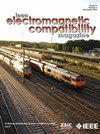Measurement Method for Mixed-Mode S-Parameters of Termination Structure in Differential Communication Line
IF 2
3区 计算机科学
Q3 ENGINEERING, ELECTRICAL & ELECTRONIC
IEEE Transactions on Electromagnetic Compatibility
Pub Date : 2024-11-27
DOI:10.1109/TEMC.2024.3495038
引用次数: 0
Abstract
Bulk current injection (BCI) tests are considered an important method of evaluating the immunity of a differential communication system. Malfunctions during BCI tests are partly caused by common-mode reflection and mode conversion of electronic control units (ECUs). Their characteristics are determined by termination structures (such as connector, enclosure, and ground wiring) and components on a printed circuit board (PCB) housed in ECUs. Conventional measurement methods using current probes cannot separate the characteristics of the termination structures for ECUs on one side because the measurement results include the effects of cable length resonances and reflections at the ECUs. Furthermore, the methods cannot measure mode conversions between the differential and common modes because currently, the current probe measures only the common mode. Thus, we cannot obtain an accurate model of the ECU on one side in the differential communication system. This study proposes a method to measure mixed-mode S-parameters of the termination structures for the ECU on one side using a current probe. We designed the load simulator on the other side to suppress the reflection and mode conversion using matched termination and balanced circuit. Consequently, we measured only the equipment under test (EUT) characteristics without cable length resonances. In addition, we placed two ports on the PCB instead of an IC to measure transmission through the EUT. Subsequently, we measured the characteristics including mode conversions. Furthermore, the effectiveness of this method was verified by SPICE simulation and experiment. In the experiment, experimental and theoretical results were compared considering measurement errors.差分通信线路终端结构混模s参数测量方法
大电流注入(BCI)测试被认为是评估差分通信系统抗扰度的重要方法。BCI测试中的故障部分是由电控单元(ecu)的共模反射和模式转换引起的。它们的特性是由终端结构(如连接器、外壳和地线)和安装在ecu中的印刷电路板(PCB)上的组件决定的。由于测量结果包括电缆长度共振和ecu反射的影响,使用电流探头的传统测量方法无法分离ecu一侧端接结构的特性。此外,这些方法不能测量差分和共模之间的模式转换,因为目前,电流探针只测量共模。因此,在差分通信系统中,我们无法得到一侧ECU的精确模型。本研究提出了一种利用电流探头在一侧测量ECU端接结构混合模s参数的方法。我们在另一侧设计了负载模拟器,利用匹配端接和平衡电路抑制反射和模式转换。因此,我们只测量了被测设备(EUT)的特性,没有电缆长度共振。此外,我们在PCB上放置了两个端口而不是IC来测量通过EUT的传输。随后,我们测量了包括模式转换在内的特性。通过SPICE仿真和实验验证了该方法的有效性。在实验中,考虑测量误差,对实验结果和理论结果进行了比较。
本文章由计算机程序翻译,如有差异,请以英文原文为准。
求助全文
约1分钟内获得全文
求助全文
来源期刊
CiteScore
4.80
自引率
19.00%
发文量
235
审稿时长
2.3 months
期刊介绍:
IEEE Transactions on Electromagnetic Compatibility publishes original and significant contributions related to all disciplines of electromagnetic compatibility (EMC) and relevant methods to predict, assess and prevent electromagnetic interference (EMI) and increase device/product immunity. The scope of the publication includes, but is not limited to Electromagnetic Environments; Interference Control; EMC and EMI Modeling; High Power Electromagnetics; EMC Standards, Methods of EMC Measurements; Computational Electromagnetics and Signal and Power Integrity, as applied or directly related to Electromagnetic Compatibility problems; Transmission Lines; Electrostatic Discharge and Lightning Effects; EMC in Wireless and Optical Technologies; EMC in Printed Circuit Board and System Design.

 求助内容:
求助内容: 应助结果提醒方式:
应助结果提醒方式:


